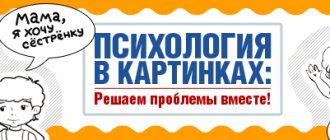Parents often encounter children's absent-mindedness even in kindergarten, but do not pay close attention to these signs, believing that as the child grows up, everything will go away on its own. An adult should be alerted to those moments where he cannot concentrate and sit quietly: modeling, mosaics, puzzles, drawing.
Despite the fact that the child is restless and inattentive, he is actively developing, running, playing and communicating with peers. When preparing for school and in the elementary grades, parents notice that the student does not remember the schedule, forgets a change of shoes, takes an unimaginably long time to do homework without completing it, and does not write down homework assignments. What to do if a child is inattentive and absent-minded, why this happens, and how parents can help the baby - let’s look at it in more detail.
Causes of absent-mindedness and inattention in children
At home, it’s easy for parents to cope with their children’s absent-mindedness, but when their child is inattentive at school, what should they do? The main thing is not to raise your voice, not to reproach or offend. If we analyze his behavior, we can suggest possible reasons for the lack of attention:
- Hyperactivity is one of the most noticeable factors, expressed in increased motor activity of the baby relative to other peers. He cannot sit for a long time at home or in class because he is constantly distracted by birds outside the window, cars, animals, etc.
- Painful conditions - the baby’s weakened body occupies all his attention, and it is very difficult for him to concentrate on one thing. This is especially true for chronic diseases that are accompanied by frequent sick leave—separation from classes and communication with classmates at school knocks the child out of his usual life.
- Lack of parental attention. Adults solve family problems by earning money, spend a lot of time on the road and spend a long time at work. All this time, the student is left to his own devices, and when his parents return home, he tries to attract their attention by any means - from hooliganism and fights to academic failure. At the same time, adults believe that he is very inattentive and cannot concentrate on his studies.
- The workload of children often deprives them of a happy childhood - a large number of lessons in swimming, languages, music, dancing, sports will certainly be an excellent investment in their successful future life, but it deprives them of the most important thing - a feeling of carelessness. If it seems to parents that the baby is uncollected and inattentive, perhaps he is simply tired and does not have time to rest.
- Wrong motivation is a common cause of absent-mindedness and forgetfulness. In this, kids are very similar to adults, who enjoy doing only those things that they really like. Why is my child inattentive at school? Perhaps he is very bored listening to this subject and does not understand why he needs it.
Problems with attention and perseverance are present in most children to varying degrees.
Under the influence of stress or irregular nutrition, insufficient rest or lack of attention on the part of adults, excessive inattention, forgetfulness or absent-mindedness can occur. In this case, it is necessary to help the student by first finding out whether such behavior is a deviation from the norm.
Looking for reasons
Observe your baby before seeking professional help. Where exactly is he being careless?
At school.
If unsatisfactory behavior is observed only within the walls of the school classroom, then the problem is most likely not with your child. Even an overly active desk neighbor can cause a child to be unable to concentrate. Sometimes it turns out that due to poor discipline in the lessons and boring presentation of the material in a monotonous voice, all the children “suffer”, and the teacher attributes his pedagogical mistakes to their inattention. Ask your child: is he interested in listening to the teacher? What's his voice like? What are other children doing at this time?
At home.
If a child studies diligently at school, completes all assignments in various sections and clubs, teachers and educators are happy with him, but at home he cannot repeat what you just asked him to do, there may be several reasons for inattention. The child can relax at home after a busy day at work. He has the right to this too! Sometimes parents need to take a closer look at their parenting style. How often do you lecture your child? If you regularly tell your child, as if on schedule, that he needs to be more attentive, the child develops a defensive reaction to such a moralizing attack: he simply stops hearing you!
Everywhere.
When your child, anywhere, when fulfilling any request or assigned task, cannot gather himself and concentrate, take this seriously. Perhaps you simply missed this moment of upbringing in early childhood, but it’s not too late to get anything back. Practice attention training at home, on walks, use every opportunity for this. Contacting a specialist would be appropriate if you see that you cannot cope on your own (you do not have enough knowledge or time for this).
If the problem cannot be solved on your own, do not neglect the advice of a specialist and be sure to go to an appointment with a neurologist. Modern medicine identifies a diagnosis such as “attention deficit hyperactivity disorder” (ADHD). With this diagnosis, many doctors recommend sending the child to swimming or other sports clubs, but the doctor’s prescription always depends on the characteristics of each specific case.
In most cases, inattention is a consequence of the lack of habit of observation and contemplation, as well as the result of insufficient attention to memory development activities.
How to recognize a deviation from the norm?
At the age of 6-7 years, a child is already conscious enough to be able to concentrate, show perseverance, and be able to store his things. When parents send their children to school, they discover that not all of these skills are present. Then you need to take a closer look at the student at home, while doing homework:
- Lessons done very quickly will tell adults that they were done superficially, without delving into and understanding.
- Prolonged time spent doing homework, sometimes not even completed;
- There are a lot of mistakes and blots in the completed tasks.
- Constant complaints about fatigue and lethargy in children even with minimal workload indicate health problems.
- The child is often distracted, lost in thought, does not study, or switches to games.
If a child is absent-minded and inattentive, what should parents do if they lose things? Do not scold or raise your voice under any circumstances, since the baby is already upset and feels guilty. Adult dissatisfaction and reprimand for losing something you spent money on will worsen the condition and can lead to childhood depression.
Strictly prohibited methods of dealing with absent-minded children
When their own child is forgetful, inattentive at school, absent-minded in class, parents understand that they need to somehow help him become attentive and collected. As a rule, the simplest way to solve this problem is to shift the responsibility onto the baby.
That is, children must look after themselves both at home and at school. For school age, such a load is unbearable, and therefore does not lead to the results desired by adults. Moral teaching, remarks, conversations begin, and as a result, the little schoolboy begins to understand that he cannot cope with this problem, and, therefore, there is no point in trying.
Psychologists have developed a number of prohibitions for parents fighting absent-minded children:
- no ridicule;
- you can’t scold;
- do without punishment;
- do not compare with peers or older children;
- avoid extremes, depriving adults of help as instruction;
- do not blame the child, since this is not only his fault, but the responsibility of the whole family.
When should you start teaching your child to be neat?
Probably, many readers remember Mayakovsky’s poem “What is good and what is bad,” which tells with examples how young children should act and what not. Remember the lines with which dad ends his instructions? “Remember this every son. Every child knows: his son will grow up to be a pig, if the son is a pig.” But a little pig grows into a pig only if it is raised by parents who themselves do not take too much care of their appearance and the order in the house.
When a baby grows up in a family where cleaning the apartment is a very rare occurrence, where parents are not too concerned about their hair and clothes, where the mother is in no hurry to change the baby’s diaper or does not wash the baby “in the mornings and evenings,” then how can she instill neatness in the older one? age? Being neat and clean are personality traits that are formed in a child from birth. They, like the skill of independence, are most often formed under the influence of the personal example of parents.
If from a very early age you do not instill in children the need to keep their clothes and rooms clean and to follow the rules of personal hygiene, then at the age of 5-6 it will be much more difficult to do this. Sloppiness and uncleanliness, carelessness and unnecessaryness make children loners and outcasts among their peers. Nobody in normal society likes sluts. Teenage children will especially suffer. After all, while younger children can somehow come to terms with those whose clothes are constantly wrinkled and their hair is unkempt, teenagers do not forgive such carelessness in appearance to any of their peers, regardless of gender.
Inattentive child - what to do?
Unlike various serious diseases, childhood absent-mindedness can be corrected by simple actions on the part of adults. At the same time, it is important not only to take care of the baby, but also to take care of yourself, without setting a bad example for him.
So, when a child is very inattentive, what to do and how to help:
- Visit a neurologist and psychologist to eliminate the possible medical cause of the behavior disorder.
- Help with homework and study, do not leave you alone in solving school problems.
- Praise for small achievements to give confidence and increase the student’s self-esteem.
- Schedule a daily routine - the amount of rest should be adequate for school age, and allocate several hours for games and walks.
- Provide comfort in the student’s workplace - a good table for homework, convenient folders for storing notebooks, shelves for textbooks, etc.
- Control your diet and make your diet healthy. The food must contain a complex of vitamins and minerals in sufficient quantities. It is advisable to serve portions without excesses - an overweight person is impervious to learning, and this will deteriorate his health.
- Help with motivation, show ways to highlight important things from the rest. Learn how to combine leisure and study.
- Monitor and help finish things started, even if it’s just a drawing or a book that wasn’t assigned at school.
Recommendations for parents: What to do if the child is inattentive
INATENTENT CHILD.
Recommendations for parents on developing attention.
Do they often complain to you that your child is inattentive, fidgets and fidgets in class, and doesn’t listen to the assignment? Well, let's figure it out: what attention is and how you can develop it in your child
Attention has certain properties: volume, stability, concentration, selectivity, distribution, switchability and arbitrariness. Violation of each of these properties leads to deviations in the child’s behavior and activities.
Small attention span
- this is the inability to concentrate on several objects at the same time, to keep them in mind.
Insufficient concentration and stability of attention
- it is difficult for a child to maintain attention for a long time without being distracted or weakening it.
Insufficient selectivity of attention
- the child cannot concentrate on exactly that part of the material that is necessary to solve the task.
The ability to switch attention is poorly developed
- it is difficult for a child to switch from performing one type of activity to another.
For example, if you first checked how your child remembered a poem, and then, at the same time, decided to test him in mathematics, then he will not be able to answer you well. The child will make many mistakes, although he knows the right answers. It’s just hard for him to quickly switch from one type of task to another. Poorly developed ability to distribute attention
- the inability to effectively (without errors) perform several tasks at the same time.
Insufficient voluntary attention
- the child finds it difficult to concentrate attention on demand.
Such shortcomings can be eliminated by “attention exercises” in the process of specially organized work. But parents can also contribute if they use these exercises at home in a free and relaxed manner.
It is important for parents and teachers to know that in preschoolers under 5–6 years of age, involuntary attention predominates. It is passive in nature, imposed on the child from the outside and skillfully organized by adults. This manifests itself in rapid distractibility, inability to concentrate on one thing, and in frequent changes of activities. Studies have shown that verbal activity (memorizing poetry, oral explanation, etc.) causes child fatigue most of all. According to physiologists, most often preschoolers are distracted by emotionally rather than informationally attractive objects.
Even before starting school, the child gradually develops voluntary attention, which involves carefully completing any task, both interesting and uninteresting. It requires strong-willed efforts from the child. The level of development of voluntary attention (amount of attention, its stability, the presence of an internal plan of action) largely determines the success of a child’s education at school.
Thus, the amount of attention affects mastering the skill of counting, concentration of attention is necessary for mastering reading, and learning to write requires a developed distribution of attention. Sustained attention allows the child to consistently learn about objects in the outside world, without slipping into extraneous connections or unimportant characteristics. The presence of stable attention is a necessary condition for the formation of an internal action plan. The ability to develop an internal plan of action allows the child to operate in his mind with images, concepts, and diagrams.
It is important for adults to know that already in preschool childhood, individual differences in the degree of stability of attention are observed in different children. Sustainability of attention depends on several reasons:
- type of nervous activity of the child;
- general condition of the body;
- emotional state of the child;
- having an interest in the activity;
- conditions in which the child is engaged.
Nervous and sick children are more likely to be distracted than calm and healthy children. In a quiet and calm environment, the child will be less distracted than in a room where the TV is on or there is an animated conversation. An angry or upset child is less able to work attentively.
Take charge of your child's attention
, involve him in various activities, highlighting their attractive sides.
Remember that what is most attractive to a child is what is visual, emotional, and unexpected.
A universal means of organizing attention is speech
. While completing a task, older preschoolers often recite the instructions out loud. Thus, a word in the form of an instruction or demand from an adult helps the child manage his attention. The most effective would be step-by-step instructions: first, the child is told the entire task, and when completed, they are given it systematically in parts (steps). Such instructions will organize the child’s attention and will facilitate the planning of his activities.
When giving a task to a child, remember that your instructions should be specific, step-by-step, understandable, and comprehensive.
If you want your child to be attentive when completing tasks, take care of your child’s good physical well-being and mood. Create silence in the room where he studies, reduce the number of distractions:
loud sounds, emotional speech, bright pictures and toys, interesting magazines and books, moving objects.
A child can be distracted by external and internal stimuli, such as his own emotional states or extraneous associations. The child needs to develop a mechanism for “dealing with interference” and focus it on completing the main activity.
To do this, give the child a task that requires effort slightly beyond the child’s potential. Words that inhibit children's distractions should not have a negative connotation.
(“Don’t get distracted!”, “Don’t look around!”, “Don’t touch the cars!”). A more successful option might be the following statements: “Let’s finish the line”, “Now let’s color in the cap and play,” “Look, you only have two letters left to write!”
The development of stability of attention will be facilitated by the child having a hobby or interest.
, a matter that is especially interesting to him. By focusing his attention on it, the baby will gain experience of an increasingly higher degree of concentration. Concentration involves being so focused on what you are doing that you don’t notice everything happening around you.
When developing children's attention, it is important to remember that interruption of activities depletes the child's mental resources.
The draining effect of interruptions is greatly affected by repeated interruptions and the need to return to the original activity again and again. The vast majority of children, in conditions of repeated interruption of activity, are unable to work at all.
Techniques for consciously switching a child’s attention can be specially taught. Switching is easier if adults tell the baby about what he has to do,
what you should distract yourself from, when you need to stop and start a new activity. So, after studying and taking a short break to rest, the baby has difficulty returning to work. It is also difficult for a preschooler to realize the end of one or another stage of work; this moment can also be indicated by some kind of visual sign. Switching attention is a transfer from one object to another, from one type of activity to another. This property of attention is especially in demand in learning; it helps to quickly navigate in any environment, including a school lesson.
It is important to remember that the distribution of attention depends on the physiological and psychological state of the child. When tired and performing difficult tasks, it usually decreases. This is especially noticeable when teaching a child to write.
Educational games and exercises
Exercise “Yes and No - don’t say.”
You can simply agree on which words or parts of speech cannot be said and then ask a variety of questions.
There should be a lot of questions. This is a frank test of attention. For example, such as: Did you have breakfast today? Do you like your hairstyle? Today is Monday? Are you late for class today? Is it winter now?
You have a brother? Do you sleep at night? Etc. The child should not answer “yes” and “no”, but replace these words with another answer
Game “What has changed?”
Development of concentration, volume, distribution of attention and visual memory.
Small objects (eraser, pencil, notepad, match, etc. in the amount of 8-10 pieces) are laid out on the table. For 30 seconds, the child looks and remembers the location of objects; then the child turns his back to the table, and at this time 2-3 objects are transferred to other places. Again, 30 seconds are given to examine the objects, after which we ask the player: what has changed in the arrangement of the objects, which of them have been moved? Exercises to develop stability and switching attention.
Call your child various words: table, bed, cup, pencil, bear, fork, etc. The baby listens carefully and claps his hands when he comes across a word that means, for example, an animal. If the baby gets confused, repeat the game from the beginning. Another time, suggest that your child stand up every time he hears a plant word. Then combine the first and second tasks, i.e. The baby claps his hands when he hears words for animals, and stands up when he hears the name of a plant. These and similar exercises develop attentiveness, speed of distribution and switching of attention, and, in addition, expand the child’s horizons and cognitive activity.
Corrector.
This exercise trains attention very well. To develop sustained attention, give your child a small text (newspaper, magazine) and ask him to cross out a letter (for example, O) while looking through each line. Then, to train distribution and switching of attention, change the task. For example, like this: “In each line, cross out the letter O, and circle the letter P.” After a few days, give the child his own work - let him check it himself and find omissions and errors (play teacher)
Exercise “Color your other half.”
Exercises to develop concentration. You need to prepare several half-colored pictures (you can cut the coloring sheets in half vertically). And the child must color the second half of the picture in the same way as the first half was painted. This task can be complicated by asking the child to first complete the second half of the picture and then color it. (This could be a butterfly, dragonfly, house, Christmas tree, etc.).
Exercise “Numerical Table”
. Show your child a table with a set of numbers from 1 to 9 (16, 25), which are arranged in random order. Tell him: “Try to find, show and say out loud the numbers from 1 to 9 (16) as quickly as possible.” Most children 5-7 years old complete this task in 1.5-2 minutes and with almost no errors. Another variation of this game: prepare a table with 16 (25) cells, on which numbers from 1 to 21 (30) are written in random order, of which 5 numbers are missing. Ask your child to find and show all the numbers in a row, and write down the missing numbers (if he cannot write down the numbers, then just have him tell them to you).
Exercise “Follow the example”
(training concentration and arbitrariness of attention). The exercise includes the task of drawing repeating patterns in cells. Each of the patterns requires increased attention of the child, because... requires him to perform several sequential actions: a) analysis of each element of the pattern; b) correct reproduction of each element; c) maintaining a sequence for a long time. When performing this type of task, it is important not only how accurately the child reproduces the sample (concentration), but also how long he can work without errors. Therefore, each time try to gradually increase the time it takes to complete one pattern. To get started, 5 minutes is enough. Options for cellular patterns may vary. Improvise.
"Find differences"
Goal: developing the ability to concentrate on details. The child draws any simple picture (a cat, a house, etc.) and passes it to an adult, but turns away. The adult completes a few details and returns the picture. The child should notice what has changed in the drawing. Then the adult and child can switch roles. There are also factory games “Find 10 (15) differences”. Invite your child to look at pictures that, for example, show two gnomes (or two kittens, or two fish). At first glance they are exactly the same. But, looking more closely, you can see that this is not so. Let your child try to spot the differences. You can also select several pictures with ridiculous content and ask your child to find the inconsistencies.
"Speak!"
Goal: developing the ability to control impulsive actions. Say the following: “I will ask you simple and difficult questions. But it will be possible to answer them only when I give the command: “Speak!” Let's practice: "What time of year is it now?" (pause) “Speak!”; “What color is our ceiling?”... “Speak!”; “What day of the week is it today?” ... “Speak!”; "How much is two plus three?" etc." You can change the signal: for example, answer after clapping, stamping, etc. Gradually increase the pauses between questions and answers or alternate their duration.
Game "Three points"
The game stimulates the development of attention span. You invite the child to take a position that is comfortable for him and freeze in it, that is, not move. In this case, the child must listen and remember three points of the task. Then you say, “One, two, three—run!” - and the child quickly completes all the points of the task, and exactly in the sequence in which they were spoken. The tasks can be very different, for example: 1. The simplest task: - Point one. Clap your hands three times; - Point two. Name some furniture; - Point three. Stand next to an object made of wood. When the child gets comfortable with the rules of the game, you can offer him a more complicated version. 2. Complicated task: - Point one. Jump as many times as you are old; - Point two. Write the name of the waterfowl in your notebook; - Point three. Stand next to an object that begins with the letter "S". The task can be complicated by increasing the number of points to 4-5.
Game "Little Beetle".
“Now we will play this game. You see, in front of you is a field lined up into squares. A beetle is crawling across this field. The beetle moves on command. It can move down, up, right, left. I will dictate your moves, and you will move the beetle across the field in the right direction. Do it mentally. You cannot draw or move your finger across the field! Attention? Let's start. One cell up, one cell left. One cell down. One cell to the left. One cell down. Show me where the beetle stopped.” If the child finds it difficult to complete the task mentally, then first you can let him show each movement of the beetle with his finger, or make a beetle and move it across the field. It is important that as a result the child learns to mentally navigate the cellular field. You can come up with a variety of tasks for the beetle. When the field of 16 cells has been mastered, proceed to move along the field of 25, 36 cells, complicate the tasks with moves: 2 cells diagonally to the right and down, 3 cells to the left, etc.
Exercise "Beads".
To work, you need at least six felt-tip pens or colored pencils. The work consists of two parts: Part I - drawing the beads, Part II - checking the work and, if necessary, redrawing the beads.
Instruction I: “You have a thread drawn on your piece of paper. On this thread you need to draw five round beads so that the thread passes through the middle of the beads. All beads must be different colors, the middle bead must be blue.” Instruction II: “Now I’ll tell you again what kind of beads you needed to draw, and you check your drawings to see if you did everything correctly. If you notice a mistake, make a new drawing nearby.” (The test condition is repeated again at a slow pace, each condition is highlighted by voice.) The conditions can be changed each time: increase the number of beads, change the color, etc.
Game “What happens?”
By playing this game, children will learn to compare, generalize the properties of objects and, finally, understand the meaning of such concepts as height, width, length;
classify objects by shape, size, color. First, the adult asks the questions, and the child answers. Then you need to give the child the opportunity to express himself. Examples: - What is tall?
(tree, pillar, person, house). Here it is appropriate to ask what is taller - a tree or a house;
person or pillar. - What is long? (short) - What is wide (narrow)? — What is round (square)?
A variety of concepts can be included in the game: what is fluffy, soft, hard, sharp, cold, white, black, etc.
Mindfulness Exercises
When parents are with their children on a walk or on a trip, you can unobtrusively offer game exercises to train attentiveness and develop memory. In addition to their effectiveness, they will entertain the baby and give a great mood:
- “What do I see” - the adult names the letter, and the baby names several objects around him that begin with it.
- “Words” - from one long word you need to make several short ones. The longer the invented word, the more combinations of syllables.
- “Puzzle” - from many fragments of one picture you need to assemble a single image (a cartoon or movie character, an animal or a flower).
- “Find the mistake” - write a short text, deliberately misspelling the words. The student’s task is to find these mistakes and write correctly.
- Chess, checkers, backgammon, board games.
- Learning poems or short texts by heart.
- Logical problems "third wheel".
- Various drawn puzzles with labyrinths.










